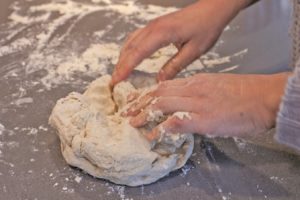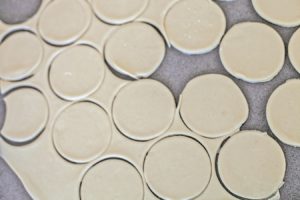We cross paths regularly on our respective early morning coffee runs in Wellfleet. Now, without masks, it seems easier to strike up a conversation. She’s holding a copy of the New York Times and soon we are talking about what is happening in Ukraine and how neighbors are planning a fundraising dinner and an art sale.
I’m glad Agata and her friends are on top of the fundraising — sign me up. I make a mental note to send a donation to chef José Andrés’s World Central Kitchen, which I know has set up to feed refugees on the Polish-Ukrainian border. I hear a little about Agata’s family ties to Ukraine and about her babcia, her grandmother in Poland, and wonder aloud what her babcia would have been most likely to feed the refugees who are streaming across the border into Poland right now.
“Pierogi was her dish,” Agata says without hesitation. “She was in charge of pierogi in the family, and I learned from her.”

“Then let’s make pierogi,” I reply. “Teach me how to make them, for Ukraine and your babcia.” Agata has firm ideas about what we need: smalec (lard), ser bialy (a kind of white farmer’s cheese), and Polish flour. Later that week on a trip to Boston, I make a detour to the Baltic Deli on Dorchester Avenue.
The Baltic is an unabashedly charcuterie-forward kind of operation. Behind counters piled with smoked meats, prepared salads, and bins of pickled things stand two women, both under five feet tall, both wearing white lab coats and sporting curled white up-dos shellacked to their heads like helmets.
As I approach the counter, the women are not smiling. But they warm up as I ooh and ahh over the cherry-smoked bacon and juniper sausages. I explain my need for ingredients for a pierogi lesson, and they have plenty to say about how to make them properly.
One of the women insists the flour be Maka Poznanska 550, which made its way into my basket. The other clerk battled me over the brand of ser bialy Agata had requested. I decided it would be easier to disappoint Agata than to argue. I left the Baltic with two grocery bags full of Polish treats, most unrelated to pierogi, and the good wishes of my new friends.

Back in Truro, as we set in on pierogi making, I learned more about Agata’s family, whose story is one of multiple displacements across central and eastern Europe over generations. Her Austrian grandfather arrived in Poland via Ukraine.
The kind of pierogi we’re making are the classic Polish version, pierogi ruskie. Ruskie, it turns out, means “Ruthenian” rather than “Russian,” as it is often mistranslated. For the historically minded, Ruthenia was the medieval Latin name for a region that stretches between what are now western Ukraine, parts of Slovakia, and southeast Poland.
The origins of pierogi are hard to trace, but the dumplings are found throughout Eastern Europe, the Baltic states, Ukraine, and Russia. In Lithuania they are known as vareniki. In Ukraine, they are called varenyky. In Russia, pelmeni are a slightly smaller version. Pierogi remind me of ravioli. They may have arrived from Asia over trading routes through Ukraine and into Europe.
I learn that pierogi ruskie are an ultimate Polish comfort food, served in traditional restaurants called “milk bars,” or at home, dressed up with cabbage and mushrooms for holiday feasts.

Our pierogi ruskie dough couldn’t be simpler: flour, salt, and warm water. Many recipes contain egg or oil, but Agata’s babcia thought that anything more than flour and water would make the pierogi heavy. When I snuck a little butter to a second batch, it seemed to add richness without affecting texture — sorry, Babcia.
While the dough rests, Agata and I prepare a filling of mashed potatoes mixed with the farmer’s cheese. Then we roll the dough out very thin and cut 3-inch rounds, which we fold into half-moons with about a teaspoon of filling. With wet fingers, we crimp the edges to seal them. Agata emphasizes the importance of the seal — if the dumplings open while they’re boiling, the filling will escape, and they will be ruined.
The dumplings are boiled until the wrappers are translucent. Patted dry, they can be eaten immediately — at this stage they have the satisfying slipperiness of dim sum pork dumplings. But I like the ones we fry in smalec until they’re brown and crispy, which, in my opinion, gives them a superior texture and more complex flavor.
I think we are both enjoying the lesson, but there is also a kind of melancholy in the air as we work. We haven’t forgotten it was a conversation about Russia’s invasion of Ukraine that prompted this lesson. What can our cooking do?
I don’t have a ready answer. The best I can come up with is that in some small way it matters to make pierogi and to celebrate Agata’s babcia. Our pierogi lesson won’t change the situation in Ukraine, but for a while it makes the war less abstract. As we cook and talk, the distance between us and people half a world away who are fighting for their existence or welcoming refugees is smaller. In that way, it changes me.
Pierogi Ruskie
For this recipe I sought out Polish farmer’s cheese (ser biały), but other versions will work. High quality lard is also worth seeking out for the topping, but it’s fine to use butter.

For the filling:
11 oz. farmer’s cheese
1 lb. russet or other starchy potatoes, peeled
2 Tbsp. melted butter
½ tsp. ground pepper
½ tsp. salt
For the dough:
4 cups all-purpose flour, plus more for rolling the dough
1 cup very warm water
3 Tbsp. melted butter
½ tsp. salt
For the onion topping:
1 medium onion, sliced
2 Tbsp. smalec (lard) or butter
Salt
Sour cream for serving
Make the filling: Place the potatoes in a pot with enough water to cover. Add the salt. Bring to a low boil and cook until a sharp knife can easily pierce the potatoes. Drain the potatoes, then put them back in the empty pot and mash them until completely smooth. Cool completely.
Crush the cheese with a fork and mix it into the cooled potatoes along with the melted butter. Season with plenty of salt and pepper.
Make the dough: Sift the flour onto a large work surface. Make a well in the mound of flour and pour in a quarter cup of warm water and the butter. Begin to work the flour into the water-butter mixture, adding more water gradually until the dough comes together into a soft, elastic ball (about 10-15 minutes). Cut the dough into 2 parts, wrap each in plastic and allow to rest for 20 minutes.
On a floured surface, roll the first dough ball into a thin (about 1/8-inch) sheet. Cut it into 3-inch circles using a biscuit or cookie cutter, or a glass. Roll out and cut the remaining ball of dough.
Bring a large pot of salted water to a rolling boil.
Place a spoonful of the filling in the middle of each circle. Fold the dough over the filling to create a half-moon shape. Using dampened fingers, press the edges of dough together tightly to seal.
Once the dumplings are made, drop them into the boiling water, 5-7 at a time. Don’t crowd them or they’ll stick together. Cook for 5-6 minutes, until the dumplings become translucent and start to float. Remove with a slotted spoon and drain. The pierogi may be eaten as is with melted butter and sour cream or cooled and frozen to finish later. Or pan fried.
To fry the pierogi, melt the smalec (or butter) in a frying pan. Add the onion for the topping and sauté until golden brown, about 15 minutes. Remove the onion and set aside. Add pierogi to the frying pan without crowding them, adding additional fat as needed; pan fry until golden brown and beginning to crisp, about 10 minutes on each side. Serve topped with fried onions, melted smalec, or butter and sour cream.
Note: Pierogi can be made ahead and frozen before they’re boiled — spread them on a baking sheet, and after they’re frozen collect them in a freezer-safe bag. Boiled pierogi can also be frozen; to finish them, brush them with butter and bake at 375o F for about 15 minutes or until golden brown.
